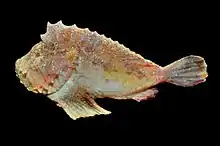| Kanekonia | |
|---|---|
 | |
| Kanekonia queenslandica | |
| Scientific classification | |
| Domain: | Eukaryota |
| Kingdom: | Animalia |
| Phylum: | Chordata |
| Class: | Actinopterygii |
| Order: | Scorpaeniformes |
| Family: | Aploactinidae |
| Genus: | Kanekonia S. Tanaka, 1915 |
| Type species | |
| Kanekonia florida S. Tanaka, 1915[1] | |
Kanekonia is a genus of marine ray-finned fish, velvetfishes belonging to the family Aploactinidae. The genus is found in the western Pacific and eastern Indian oceans.
Taxonomy
Kanekonia was originally described as a genus in 1915 by the Japanese ichthyologist Shigeho Tanaka when he was describing the new species Kanekonia florida from Japan, its type species by monotypy.[1][2] The genus Kanekonia is classified within the family Aploactinidae in the suborder Scorpaenoidei within the order Scorpaeniformes,[3] although this family is also treated as a subfamily of the stonefish family Synanceiidae[4][5] within the Scorpaenoidei, which in turn is treated as a superfamily within the order Perciformes.[6] The name of the genus, Kanekonia honours Ichiro Kaneko, who supplied Tanaka with fishes from a fish market in Nagasaki, Japan, including the holotype of K. florida.[7]
Species
There are currently four recognized species in this genus:[8]
Characteristics
Kanekonia velvetfishes are characterised by having a short, deep body with an extremely large head and mouth, with a protruding lower jaw. The preoperculum has 5 blunt spines. The scales take the form of outwardly directed spines, similar to tiny papillae with those on the back and flanks being the largest. They have a continuous dorsal fin which has its origin above the rear part of the eye The spiny part of this fin is longer than the soft-rayed part.[10] The dorsal fin has 11 to 13 spines and 7 to 10 sof rays, while the anal fin has a 1 or 2 spines and between 7 and 9 soft rays. The fin spines do not have venom glands.[9] These are small fishes, the largest species is the deep velvetfish (K. queenslandica) which reaches a maximum total length of 6.4 cm (2.5 in).[8]
Distribution and habitat
Kanekonia velvetfishes are found in the eastern Indian and western Pacific Oceans.[8] These fishes are demersal and are found mainly on sandy substrates.[11][12]
References
- 1 2 Eschmeyer, William N.; Fricke, Ron & van der Laan, Richard (eds.). "Genera in the family Aploactininae". Catalog of Fishes. California Academy of Sciences. Retrieved 27 April 2022.
- ↑ Eschmeyer, William N.; Fricke, Ron & van der Laan, Richard (eds.). "Species in the genus Kanakonia". Catalog of Fishes. California Academy of Sciences. Retrieved 27 April 2022.
- ↑ J. S. Nelson; T. C. Grande; M. V. H. Wilson (2016). Fishes of the World (5th ed.). Wiley. pp. 468–475. ISBN 978-1-118-34233-6.
- ↑ Smith, W. Leo; Smith, Elizabeth; Richardson, Clara (February 2018). "Phylogeny and Taxonomy of Flatheads, Scorpionfishes, Sea Robins, and Stonefishes (Percomorpha: Scorpaeniformes) and the Evolution of the Lachrymal Saber". Copeia. 106 (1): 94–119. doi:10.1643/CG-17-669.
- ↑ Willingham, AJ (13 April 2018). "Stonefish are already scary, and now scientists have found they have switchblades in their heads". CNN.
- ↑ Ricardo Betancur-R; Edward O. Wiley; Gloria Arratia; et al. (2017). "Phylogenetic classification of bony fishes". BMC Evolutionary Biology. 17 (162): 162. doi:10.1186/s12862-017-0958-3. PMC 5501477. PMID 28683774.
- ↑ Christopher Scharpf & Kenneth J. Lazara, eds. (10 March 2022). "Order Perciformes (Part 10): Suborder Scorpaenoidei: Families Apistidae, Tetrarogidae, Synanceiidae, Aploacrinidae, Perryenidae, Eschmeyeridae, Pataecidae, Gnathanacanthidae, Congiopodidae and Zanclorhynchidae". The ETYFish Project Fish Name Etymology Database. Christopher Scharpf and Kenneth J. Lazara. Retrieved 27 April 2022.
- 1 2 3 Froese, Rainer and Pauly, Daniel, eds. (2013). Species of Kanekonia in FishBase. December 2013 version.
- 1 2 Johnson, J.W. (2013). "Kanekonia leichhardti, a new species of velvetfish (Actinopterygii: Scorpaeniformes: Aploactinidae) from the Gulf of Carpentaria, Queensland, Australia" (PDF). Memoirs of the Queensland Museum – Nature. 58: 397–410.
- ↑ Dianne J. Bray. "Kanekonia". Fishes of Australia. Museums Victoria. Retrieved 27 April 2022.
- ↑ Dianne J. Bray (2018). "Kanekonia queenslandica". Fishes of Australia. Museums Victoria. Retrieved 27 April 2022.
- ↑ Froese, Rainer; Pauly, Daniel (eds.) (2022). "Kanekonia leichhardti" in FishBase. April 2022 version.